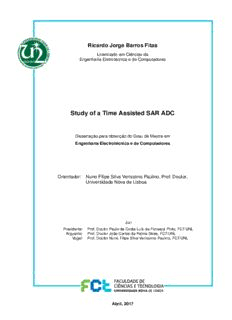Table Of ContentRicardo Jorge Barros Fitas
Licenciado em Ciências da
Engenharia Eletrotécnica e de Computadores
Study of a Time Assisted SAR ADC
Dissertação para obtenção do Grau de Mestre em
Engenharia Electrotécnica e de Computadores
Orientador: Nuno Filipe Silva Veríssimo Paulino, Prof. Doutor,
Universidade Nova de Lisboa
Júri
Presidente: Prof.DoutorPaulodaCostaLuísdaFonsecaPinto,FCT-UNL
Arguente: Prof.DoutorJoãoCarlosdaPalmaGoes,FCT-UNL
Vogal: Prof.DoutorNunoFilipeSilvaVeríssimoPaulino,FCT-UNL
Abril, 2017
StudyofaTimeAssistedSARADC
Copyright©RicardoJorgeBarrosFitas,FaculdadedeCiênciaseTecnologia,Universidade
NOVAdeLisboa.
A Faculdade de Ciências e Tecnologia e a Universidade NOVA de Lisboa têm o direito,
perpétuo e sem limites geográficos, de arquivar e publicar esta dissertação através de
exemplaresimpressosreproduzidosempapeloudeformadigital,ouporqualqueroutro
meio conhecido ou que venha a ser inventado, e de a divulgar através de repositórios
científicosedeadmitirasuacópiaedistribuiçãocomobjetivoseducacionaisoudeinves-
tigação,nãocomerciais,desdequesejadadocréditoaoautoreeditor.
Acknowledgements
Firstofall,IwouldliketostartthankingProf. NunoPaulinoforhissupport,commitment,
patience and motivation to find new approaches to problems which kept emerging. I
would also like to show my gratitude to all the other Professors at DEE FCT-UNL who,
despitenothavingtheresourcesmostofthemwouldlikeanddeservetohave, dotheir
bestonadailybasistopasstheirknowledgeandexperience.
My friends and colleagues cannot be forgotten. Many interesting discussions and
momentsoffunandlaughterwerecertainlysomeofthebestIhadsofar.
Last, but not least, I thank my parents, brother, sister and grandparents, for all the
caring,supportandencouragementtodomoreandwellthroughtheentirelengthofmy
academicpath. AndtoAndreia,whohasbeenwithmeforthepastthreeyears,present
forthegoodandthebad,forallherloveandsupportandforkeepingmegoingwhenI
thoughtIcouldn’tdomore.
v
Abstract
The demand for low power systems has been increasing in recent years and Analog-
to-DigitalConverters(ADCs)arekeyblocksofmanyofthesesystemsastheyconverta
physicalquantityintothedigitaldomainsothatthisinformationcanbefurtherprocessed
orstoredusingdigitaltechniques.
DataConvertersbasedonChargeRedistributionusingofSuccessiveApproximation
Registers(SAR)arebecomingoneofthemostpopularADCarchitecturesformoderate
speed,mediumresolutionandlowpowerapplications. Duetotheirlowanalogcomplex-
itySARADCsbenefitfrom technologyscaling. However, thisscalingoftencomeswith
asupplyvoltagereductionandthenoiselevelsdonotdecreaseatthesamerate, which
translatesintoaperformancedecrease. Therefore,newopportunitiesemergetoexplore
otherphysicalquantitiessuchastime,frequency,phaseorchargeinthecircuit.
This thesis focuses on studying how the time domain information can be used to
increase the performance of SAR ADCs. To do so, a new SAR ADC architecture is pro-
posed in which a Time-to-Digital Converter (TDC) is used to convert the time domain
information,providedbythecomparator,intothedigitaldomain. Thisnewarchitecture
was modelled in MATLAB as a 12 bit TDC assisted SAR ADC, using information from
electricalsimulationsofthecomparatorandtheTDC,designedinCadencein65nmST
MicroelectronicsCMOStechnology.
Simulationresultsdemonstratedthat,toachieveabetterperformancewhencompared
to more traditional SAR structures, the TDC energy and latency should be minimized.
Anotherlimitingfactorwasthelargevoltagerangeinwhichonly1bitcouldbeextracted
fromthetime-to-voltageconversionbytheTDCduetothecomparator’sfastresponsein
thisrange. TheproposedarchitecturewasalsoextendedtoincorporateaBypassWindow
inthetimedomain,whichallowedtosubstantiallydecreasethenumberofclockcycles
necessarytosolvethe12bitsoftheADC.
Keywords: Analog-to-Digital Converter, Successive Approximation Register, Time-to-
DigitalConverter,Lowpower,Time,BypassWindow.
vii
Resumo
AprocuraporsistemasdebaixapotênciatemvindoaaumentareosConversoresAnalógico-
Digitais (ADCs) são blocos-chave de muitos desses sistemas, dado que convertem uma
quantidadefísicaparaodomíniodigital,paraqueessainformaçãopossaserprocessada
digitalmente.
OsconversoresbaseadosemRedistribuiçãodeCarga,utilizandoRegistosdeAproxi-
maçõesSucessivas(SAR),estãoaaumentarasuapopularidade,sendoumadasarquitetu-
rasmaispopularesatualmente.Devidoàsuabaixacomplexidadeanalógica,osconverso-
resSARbeneficiamdoescalamentodatecnologiaquevemmuitasvezesassociadoauma
reduçãodatensãodealimentação,etendoemcontaqueosníveisderuídonãodiminuem
namesmamedida,istotraduz-senumadiminuiçãododesempenho.Destemodo,surgem
novasoportunidadesparaexploraroutrasquantidadesfísicas,comotempo,frequência,
faseoucarganoscircuitos.
Estatesetemcomoobjetivooestudodecomoainformaçãonodomíniodotempopode
ser utilizada para aumentar o desempenho dos conversores SAR. Para isso, é proposta
umanovaarquiteturadeumADC,naqualumConversorTempo-para-Digital(TDC)é
usado para converter a informação do domínio do tempo, fornecida pelo comparador,
paraodomíniodigital.EstanovaarquiteturafoimodeladaemMATLABcomoumSAR
ADC de 12 bits assistido por um TDC, utilizando resultados de simulação de circuitos
projetadosnatecnologiaCMOS65nmdaSTMicroelectronics.
Osresultadosdasimulaçãodemonstraramque,paraseobterummelhordesempenho
quandocomparadocomestruturasSARmaistradicionais,aenergiaealatênciadoTDC
devemserminimizadas.Outrofatorlimitadoréagrandegamadetensãonaqualsomente
1 bit pode ser extraído da conversão de tempo para tensão pelo TDC devido à rápida
resposta do comparador nesta gama. A arquitetura proposta foi, ainda, modificada de
modo a incorporar uma janela de Bypass o que permitiu diminuir substancialmente o
númerodeciclosderelógionecessáriospararesolveros12bitsdoADC.
Palavras-chave: ConversorAnalógico-Digital,RegistodeAproximaçõesSucessivas,Con-
versorTempo-para-Digital,Baixapotência,Tempo,JaneladeBypass.
ix
Description:2 Analog-to-Digital Conversion Fundamentals. 5 both capacitive DACs during this phase. Q+. C3. = 4C. (. V +. DACC 3. −0. ) +2C. (. V +. DACC3.

